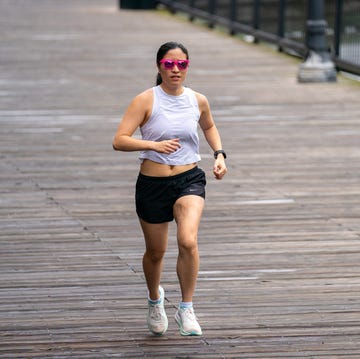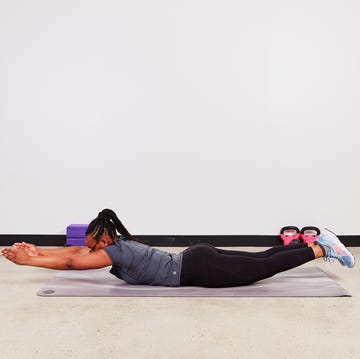A strong core provides stability and supports healthy posture and form, allowing you to run faster and more efficiently. And you don’t need to dedicate a ton of time to strengthening your midsection to see results.
That’s why Alison Staples, run coach at Run to the Finish and physical therapy assistant, developed this unique 10-minute abs workout just for runners. It includes a 360-degree approach to core training with just four functional exercises.
Expect to feel the effects of this circuit in the muscles of your torso, especially the obliques—that’s intentional. “Running is not just a forward and back movement,” Staples says. “Runners will find targeting these side muscles will improve strength and stability.”
4 Moves to Build Core Stability in 10 Minutes
How to do this workout: Complete 2 sets of the following exercises in order. Perform each exercise for 60 seconds (or 30 seconds per side), resting 15 seconds between exercises.
In the video, Staples demonstrates the moves so you can learn the form. You will need a medium dumbbell or kettlebell. An exercise mat is optional.
1. Standing Dead Bug
Why it works: This move engages the transverse abdominal muscles, which helps to stabilize the pelvis when you run.
How to do it:
- Stand with feet together and extend arms overhead, palms facing in. This is the starting position.
- Raise left knee to hip height while lowering right arm to place hand on raised knee.
- Press down on knee for 3 seconds, using core strength to resist the force of hand.
- Return to starting position.
- Repeat on the other side with right leg and left arm.
- Continue alternating, focusing on form over speed.
2. Half-Kneeling Halo
Why it works: This move will force you to focus on trunk stability. On a run, your trunk needs to remain strong while your arms and legs move.
How to do it:
- Start in a half-kneeling position with knees bent at 90-degree angles, left foot in front.
- Holding a dumbbell or kettlebell in front of chin, engage core, then circle the weight around head to the left (as if forming a “halo” overhead), making a full circle so weight ends up back in front of chin.
- Repeat for 30 seconds.
- Then switch directions for another 30 seconds. Move slow, keeping core engaged.
- On the second set, start with right foot in front.
3. Modified Side Plank With Oblique Crunch
Why it works: The obliques—muscles that stretch from your ribs down to your hips—control pelvic rotation. With strong obliques and a stable pelvis, your legs can more fully extend back and pull forward into the next stride. This helps to make your run more efficient.
How to do it:
- Place right forearm on ground directly under shoulder and stack shoulders and hips. Extend left leg and bend right knee 90 degrees, foot behind you, knees stacked.
- Lift hips to form a straight line from head to feet. Extend left arm overhead. This is the starting position.
- With a straight knee and pointed toes, lift left leg 45 degrees and draw left elbow toward left hip with a side crunch.
- Return to starting position.
- Repeat for 30 seconds.
- Then switch sides and repeat for 30 seconds.
4. Glute Bridge Walkout
Why it works: Yes, you run on your legs, but your glutes—the largest muscles in your body—are the primary running muscles. This move isolates and activates those muscles, which will help improve your power.
How to do it:
- Lie faceup, knees bent, and feet planted on the floor.
- Drive through heels, contracting the glutes to send hips up toward the ceiling; body should form a straight line from shoulders to knees.
- Staying on heels, step right foot forward, then left.
- Keeping glutes lifted, continue to take small steps forward until legs are nearly straight.
- Then, slowly walk heels back to a bridge position and lower hips to the ground.
- Repeat.












